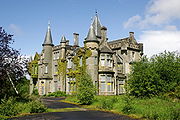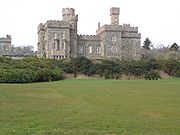
Charles Wilson (architect)
Encyclopedia

Scotland
Scotland is a country that is part of the United Kingdom. Occupying the northern third of the island of Great Britain, it shares a border with England to the south and is bounded by the North Sea to the east, the Atlantic Ocean to the north and west, and the North Channel and Irish Sea to the...
architect from Glasgow
Glasgow
Glasgow is the largest city in Scotland and third most populous in the United Kingdom. The city is situated on the River Clyde in the country's west central lowlands...
.
Biography
Charles Wilson was the younger son of a Glasgow-based master mason and builder. After working for his father, he was articled to the architect David HamiltonDavid Hamilton (architect)
David Hamilton was a Scottish architect based in Glasgow. He has been called the "father of the profession" in Glasgow. Notable works include Hutchesons' Hall, Nelson Monument in Glasgow Green and Lennox Castle. The Royal Exchange in Queen Street is David Hamilton's best known building in Glasgow...
in 1827. In Hamilton's office, Wilson worked on jobs including Hamilton Palace
Hamilton Palace
Hamilton Palace was a large country house located north-east of Hamilton, South Lanarkshire, Scotland. The former seat of the Dukes of Hamilton, it was built in 1695 and subsequently much enlarged. The house was demolished in 1921 due to ground subsidence despite inadequate evidence for that...
, the Glasgow Royal Exchange, Castle Toward
Castle Toward
Castle Toward is an outdoor education facility, based in a nineteenth century country house on the southern tip of the Cowal peninsula in Argyll, Scotland.-Toward Castle:...
and Lennox Castle.
Wilson left Hamilton's practice in 1837 to take over his father's business, together with his elder brother John. This partnership only lasted for two years, after which Charles Wilson established his own architecture practice. His early work was influenced by the architectural style of his former employer, including Italianate
Italianate architecture
The Italianate style of architecture was a distinct 19th-century phase in the history of Classical architecture. In the Italianate style, the models and architectural vocabulary of 16th-century Italian Renaissance architecture, which had served as inspiration for both Palladianism and...
and Greek revival
Greek Revival architecture
The Greek Revival was an architectural movement of the late 18th and early 19th centuries, predominantly in Northern Europe and the United States. A product of Hellenism, it may be looked upon as the last phase in the development of Neoclassical architecture...
buildings. Due to financial problems at David Hamilton's firm, which was sequestrated
Sequestration (law)
Sequestration is the act of removing, separating, or seizing anything from the possession of its owner under process of law for the benefit of creditors or the state.-Etymology:...
in 1844, Wilson gained work that might have been expected to go to Hamilton, including the commission for the City Lunatic Asylum
Gartnavel Royal Hospital
Gartnavel Royal Hospital is a mental health facility based in the west end of Glasgow, Scotland. It provides inpatient psychiatric care for the population of the West of the City; covering Hillhead, Partick, Scotstoun, Yoker, Clydebank, Drumchapel, Bearsden and Milngavie...
at Gartnavel in 1840. In preparation for this project, Wilson travelled to asylums in England and France.

Neoclassical architecture
Neoclassical architecture was an architectural style produced by the neoclassical movement that began in the mid-18th century, manifested both in its details as a reaction against the Rococo style of naturalistic ornament, and in its architectural formulas as an outgrowth of some classicizing...
increasingly influenced his work during the 1840s and 1850s, although he also produced work in the Scots Baronial style. During this period he worked on numerous residential villas, and several public buildings including the Queens Rooms (1856) and the Free Church College (1859–1861), both in Glasgow. He was responsible for the Duke Street
Duke Street, Glasgow
Duke Street is a street running to the East End of Glasgow from the High Street in the City Centre, through the residential district of Dennistoun, running past The Forge Shopping Centre, before terminating at a junction with the Great Eastern Road , Westmuir Street and Springfield Road, to form a...
Cotton Mill and the Neilson Institute in Paisley
Paisley
Paisley is the largest town in the historic county of Renfrewshire in the west central Lowlands of Scotland and serves as the administrative centre for the Renfrewshire council area...
(both 1849). In 1851 Wilson prepared a master plan for the Park district of Glasgow, the core of which was taken forward as Park Circus, although other parts of his scheme were not adopted. He also assisted Sir Joseph Paxton with the layout for the adjacent Kelvingrove Park
Kelvingrove Park
Kelvingrove Park is a public park located on the River Kelvin in the West End of the city of Glasgow, Scotland, containing the world-famous Kelvingrove Art Gallery and Museum.-History:...
. Wilson's design for 22 Park Circus
22 Park Circus, Glasgow
22 Park Circus is a townhouse in Glasgow, Scotland, housing the city's register office.-Construction:The house forms part of Park Circus, the focal point of the formerly-residential Park district of the West End of the city...
was executed after his death. His important mansions include the castellated Lews Castle
Lews Castle
Lews Castle is a Victorian era castle located west of the town of Stornoway, Isle of Lewis, Scotland. It was built in the years 1847-57 as a country house for Sir James Matheson who had bought the whole island a few years previously with his fortune from the Chinese Opium trade...
, Stornoway
Stornoway
Stornoway is a burgh on the Isle of Lewis, in the Outer Hebrides of Scotland.The town's population is around 9,000, making it the largest settlement in the Western Isles and the third largest town in the Scottish Highlands after Inverness and Fort William...
(1847–1857), for Sir James Matheson
James Matheson
Sir James Nicolas Sutherland Matheson, 1st Baronet , born in Shiness, Lairg, Sutherland, Scotland, was the son of Captain Donald Matheson, a Scottish trader in India...
.
Wilson was a founder-member of the Architectural Institute of Scotland in 1850, and of the Glasgow Architectural Society in 1858, of which he became President in 1860, although due to failing health he was succeeded as President by Alexander Thomson
Alexander Thomson
Alexander "Greek" Thomson was an eminent Scottish architect and architectural theorist who was a pioneer in sustainable building. Although his work was published in the architectural press of his day, it was little appreciated outwith Glasgow during his lifetime...
the following year. Wilson's former assistant, David Thomson, returned to his firm as a partner shortly after, taking on the running of the practice. In February 1863 Charles Wilson died of dropsy, and was buried in Glasgow's Southern Necropolis, close to the gateway he had designed in 1848. Besides David Thomson, architects trained in Wilson's practice include Thomas Ross
MacGibbon and Ross
David MacGibbon and Thomas Ross were Scottish architects. Their practice, MacGibbon and Ross was established in 1872 and continued until 1914...
, James Boucher and James Cousland.
External links
- Charles Wilson (1810–63), Glasgow - City of Sculpture
- Charles Wilson 1810–1863, Gazetteer for Scotland
- Charles Wilson, City of the Dead: Glasgow Southern Necropolis Guide

